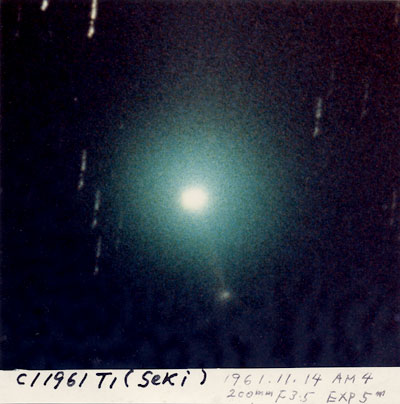This comet played a pivotal role in my life. I had been using
a 15cm reflector, but eventually abandoned it. When I switched to a smaller
9cm refractor, I was overwhelmed by queries from other comet hunters: "Why
have you chosen a smaller telescope?" Following my example, many of
them switched to the same aperture telescopes using the same magnification
as my new comet seeker.
There was a good reason for my switching to the 9cm refractor.
I had been struggling in the previous 10 years with the narrow field of
view of the 15cm reflector compounded by hopelessly inaccurate focusing.
I was physically and psychologically exhausted. To make a fresh start,
I started to look for a comet seeker, small but with better focusing and
more efficient wider field of view.
This new comet seeker was equipped with one of the few superb
mirrors ground and hand-figured by the renowned mirror maker Mr. Takao
Namura. I used to observe at a factory site in front of my house, but I
set up a new observing site at the courtyard of my home, about 80 meters
south. With the use of a 33mm Erfle eyepiece I obtained a true field width
of 3.5 degrees. As a result, my observation became so efficient that I
was able to sweep most of the eastern sky within an hour. Later I discovered
Comet Ikeya-Seki with this telescope. Prior to the discovery I unsuccessfully
searched the northeastern sky. Only 10 minutes remaining, I swept across
the southeastern sky and discovered this comet. If I had been using the
less efficient 15cm reflector, I definitely would not have discovered this
comet. A sharply focused field of view helps the observer's concentration.
Fuzzy objects drifting near the edge of the eyepiece field can be clearly
differentiated from the stars. Thus I was able to capture this 7th- to
8th-magnitude comet in the low altitude sky (10 degrees above the horizon)
already paled by morning twilight. It was a fresh start in my life which
until then had been overwhelmed by successive failures.
Comet Seki was the first comet discovered in Japan in 6 years
since the discovery of Comet Honda in 1955. This diminutive 9cm (88mm to
be exact) lens started Japan's comet hunting boom.
Comet Seki hurtled toward the earth as if plunging into it.
About a month later, mid November, 1961, it got as close as 0.1 AU to the
earth. It moved as much as 35 degrees a day in the sky. On the morning
of November 14 the comet shined at 3rd magnitude and its coma was as large
as 40 minutes in diameter. Although I did not have much experience with
astrophotography, I attached a 200mm telephoto lens to my Pentax and shot
the comet, believe it or not, on an altazimuth mounting! It was an early
morning event and not reported in newspapers. Very few people in Japan
must have seen this event and probably I would have been the only person
in Kochi City watching this mid-night spectacle. Seeing Comet Seki moving
southward through Centaurus, I relished the success I achieved as a result
of my continuous efforts.
Copyright © 2006 Tsutomu Seki.

